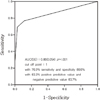Abstract
Purpose
The purpose of this methodological study was to examine the reliability and validity of a translated Korean version of the Critical Care Pain Observation Tool (CPOT) developed for assessment of pain in critically ill nonverbal patients.
Methods
A cross-sectional study design was used. Data were collected from a convenience sample of 202 critically ill patients admitted to a university hospital. Upon establishment of content and translation equivalence between the English and Korean version of CPOT, psychometric properties were evaluated.
Results
The interrater reliability was found to be acceptable with the weighted kappa coefficients of .81-.88. Significant high correlations between the CPOT and the Checklist of Nonverbal Pain Indicators were found indicating good concurrent validity (r=.72-.83, p<.001). Data showed the area under the ROC curve of 0.86 with a cut-off point of 1, which resulted in 76.9% sensitivity and 88.6% specificity. The mean score of CPOT during suctioning was significantly different from that of before (t=-14.16, p<.001) or 20 minutes after suctioning (t=16.31, p<.001).
References
1. Berne R.M., Levy M.N. Cardiovascular physiology. 1986. 5th ed. St Louis, MO: CV Mosby Co.
2. Bieri D., Reeve R.A., Champion G.D., Addicoat L., Ziegler J.B. The faces pain scale for the self-assessment of the severity of pain experienced by children: Development, initial validation, and preliminary investigation for ratio scale properties. Pain. 1990. 41:139–150. http://dx.doi.org/10.1016/0304-3959(90)90018-9.
3. Cade C. Clinical tools for the assessment of pain in sedated critically ill adults. Nursing in Critical Care. 2008. 13:288–297.
4. Carrasco G. Instruments for monitoring intensive care unit sedation. Critical Care. 2000. 4:217–225. http://dx.doi.org/10.1186/cc697.
5. Chapman D.W., Carter J. Translation procedures for the cross cultural use of measurement instruments. Educational Evaluation and Policy Analysis. 1979. 1(3):71–76. http://dx.doi.org/10.3102/01623737001003071.
6. Feldt K.S. The checklist of nonverbal pain indicators. Pain Management Nursing. 2000. 1(1):13–21. http://dx.doi.org/10.1053/jpmn.2000.5831.
7. Fraser G.L., Riker R.R. Monitoring sedation, agitation, analgesia, and delirium in critically ill adult patients. Critical Care Clinics. 2001. 17:967–988. http://dx.doi.org/10.1016/S0749-0704(05)70189-5.
8. Gélinas C., Fillion L., Puntillo K.A., Viens C., Fortier M. Validation of the critical-care pain observation tool in adult patients. American Journal of Critical Care. 2006. 15:420–427.
9. Gélinas C., Fillion L., Puntillo K.A. Item selection and content validity of the critical-care pain observation tool for non-verbal adult. Journal of Advanced Nursing. 2009. 65:203–216. http://dx.doi.org/10.1111/j.1365-2648.2008.04847.x.
10. Gélinas C., Harel F., Fillion L., Puntillo K.A., Johnston C. Sensitivity and specificity of the critical-care pain observation tool for the detection of pain in intubated adults after cardiac surgery. Journal of Pain and Symptom Management. 2009. 37(1):58–67.
11. Gélinas C., Johnston C. Pain assessment in the critically ill ventilated adult: Validation of the critical-care pain observation tool and physiologic indicators. The Clinical Journal of Pain. 2007. 23:497–505. http://dx.doi.org/10.1097/AJP.0b013e31806a23fb.
12. Greiner M., Pfeiffer D., Smith R.D. Principles and practical application of the receiver-operating characteristic analysis for diagnostic tests. Preventive Veterinary Medicine. 2000. 45:23–41. http://dx.doi.org/10.1016/S0167-5877(00)00115-X.
13. Hamill-Ruth R.J., Marohn M.L. Evaluation of pain in the critically ill patient. Critical Care Clinics. 1999. 15:35–54. http://dx.doi.org/10.1016/S0749-0704(05)70038-5.
14. Hwang Y.H., Choe M.A. Study on the changes in limb circumferences and muscle areas of critically ill patients using ventilators. Journal of Korean Academy of Nursing. 2008. 38:874–880. http://dx.doi.org/10.4040/jkan.2008.38.6.874.
15. Kim Y.H., Koo M.J., Kim S.H., Kim Y.M., Lee N.Y., Chang K.O. The experiences of patients in intensive care units. Journal of Korean Academy of Nursing. 2007. 37:924–931.
16. Li D., Puntillo K., Miaskowski C. A review of objective pain measures for use with critical care adult patients unable to self-report. The Journal of Pain. 2008. 9(1):2–10. http://dx.doi.org/10.1016/j.jpain.2007.08.009.
17. Nunnally J.C., Bernstein I.H.. Psychometric theory. 1994. 3rd ed. New York, NY: McGraw-Hill.
18. Nygaard H.A., Jarland M. The checklist of nonverbal pain indictors(CNPI): Testing of reliability and validity in Norwegian nursing homes. Age and Ageing. 2006. 35(1):79–81. http://dx.doi.org/10.1093/ageing/afj008.
19. Odhner M., Wegman D., Freeland N., Steinmetz A., Ingersoll G. Assessing pain control in nonverval critically ill adults. Dimensions of Critical Care Nursing. 2003. 22:260–267.
20. Payen J.F., Bru O., Bosson J.L., Lagrasta A., Novel E., Deschaux I, et al. Assessing pain in critically ill sedated patients by using a behavioral pain scale. Critical Care Medicine. 2001. 29:2258–2263.
21. Payen J.F., Chanques G., Mantz J., Hercule C., Auriant I., Leguillou J.L, et al. Current practices in sedation and analgesia for mechanically ventilated critically ill patients: A prospective multicenter patient-based study. Anesthesiology. 2007. 106:687–695. http://dx.doi.org/10.1097/01.anes.0000264747.09017.da.
22. Puntillo K.A., Morris A.B., Thomson C.L., Stanik-Hutt J., White C.A., Wild L.R. Pain behaviors observed during six common procedure: Result from thunder project II. Critical Care Medicine. 2004. 32:421–427. http://dx.doi.org/10.1097/01.CCM.0000108875.35298.D2.
23. Puntillo K.A., Stannard D., Miakowski C., Kehrle K., Gleeson S. Use of pain assessment and intervention notation(P.A.I.N) tool in critical care nursing practice: Nurses evaluation. Heart & Lung. 2002. 31:303–314. http://dx.doi.org/10.1067/mhl.2002.125652.
24. Sessler C.N., Varney K. Patient-focused sedation and analgesia in the ICU. Chest. 2008. 133:552–565. http://dx.doi.org/10.1378/chest.07-2026.
25. Shannon K., Bucknall T. Pain assessment in critical care: What have we learnt from research. Intensive and Critical Care Nursing. 2003. 19:154–162.
26. Siffleet J., Young J., Nikoletti S., Shaw T. Patients' self-report of procedural pain in the intensive care unit. Journal of Clinical Nursing. 2007. 16:2142–2148. http://dx.doi.org/10.1111/j.1365-2702.2006.01840.x.
27. Stanik-Hutt J.A., Soeken K.L., Belcher A.E., Fontaine D.K., Gift A.G. Pain experience of traumatically injured patients in a critical care setting. American Journal of Critical Care. 2001. 10:252–259.
28. Swets J.A. Measuring the accuracy of diagnostic systems. Science. 1988. 240:1285–1293. http://dx.doi.org/10.1126/science.3287615.
29. Teasdale G., Jennett B. Assessment of coma and impaired consciousness. A practical scale. Lancet. 1974. 2:81–84.
30. Wang H., Tsai Y. Nurse's knowledge and barriers regarding pain management in intensive care units. Journal of Clinical Nursing. 2010. 19:3188–3196. http://dx.doi.org/10.1111/j.1365-2702.2010.03226.x.




 PDF
PDF ePub
ePub Citation
Citation Print
Print







 XML Download
XML Download